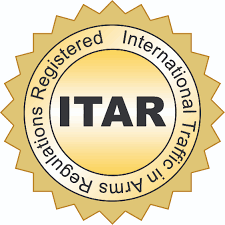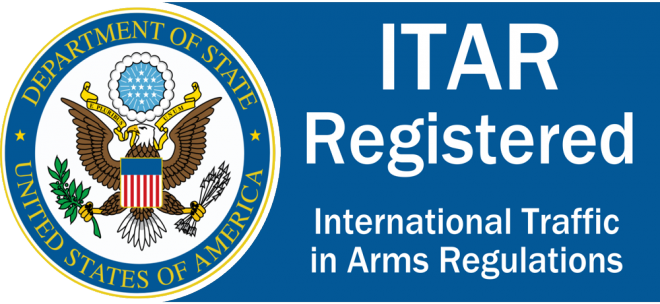If you’ve purchased weaponlights, lasers, body armor, night vision or other “specialty equipment” related to the firearms industry, the term ITAR Restricted may have made an appearance on your documentation or on product websites. The International Traffic In Arms Regulations or ITAR and the categories outlined in the United States Munitions List or USML is a way to prevent certain technologies from ending up in enemy hands and used against U.S. or Allied Forces. Zero arguments there.
The problem is that ITAR and the USML Categories are a complex set of regulations that can be unclear to even the most active export businesses and organizations. So how does ITAR effect you as an individual? Let’s attempt to boil it down.

ITAR& USML: What Is It And Why Should You Care?
First things first: I am not a lawyer or an export compliance specialist. Do not attempt to use this basic writeup as guidance for adherence of the laws surrounding ITAR restricted information.
The basics:
1) What is an export?
In simple terms, anything leaving the U.S. or an outbound crossing of a U.S. border (or a functional equivalent of the border) is an export. Obviously, a U.S. business who sells tortilla chips to international customers is engaged in the business of exporting.
Less obviously, you as an individual traveler who decides to leave the U.S. for France with an IR capable flashlight, for example, is also exporting an item, even if you intend or returning to the U.S. with the IR flashlight. For the most part, items that travel with you abroad are relatively benign and will not require a Customs Declaration. However, items that are ITAR Restricted require an export license or cannot leave our borders. Resources: Northwestern University – Florida State University – Wikipedia
YOU are responsible for following all the export laws and regulations.
2) International Shipping:
Yes, you as an individual are exporting when you ship an item outside of the United States. This means that if you are selling items on online forums or marketplaces like eBay, you are responsible for following all the export laws and regulations for that particular item. Resource: DHL
3) Non-U.S. Citizens/Foreign Nationals:
When it comes to ITAR controlled items, the mere fact of handing something to a foreign national could be a violation. Following the law means knowing your equipment and knowing the citizenship status of the person you are handing it to. Resource: University of Pittsburgh
4) Documetation, User Manuals and Technical Materials:
Not only is the item you own or use ITAR controlled, but the documentation and technical specifications could also be ITAR controlled. This includes posting information online. Resource: Cornell Law School
ITAR & USML- Department Of State
U.S. Export Control Legislation and Authorities
The Arms Export Control Act (AECA) is the cornerstone of U.S. munitions export control law. The Department of State implements this statute by the International Traffic in Arms Regulations (ITAR). All persons or entities that engage in the manufacture, export, or brokering of defense articles and services must be registered with the U.S. government. The ITAR sets out the requirements for licenses or other authorizations for specific exports of defense articles and services. The AECA requires the State Department to provide an annual and quarterly report of export authorizations to Congress. Certain proposed export approvals and reports of unauthorized re-transfers also require congressional notification.
The Export Administration Act of 1979, as amended, authorizes the Department of Commerce, in consultation with other appropriate agencies, to regulate the export or re-export of U.S.-origin dual-use goods, software, and technology. The Department of Commerce implements this authority through the Export Administration Regulations (EAR). In addition to export controls agreed in the multilateral regimes, the Department of Commerce also imposes certain export and re-export controls for foreign policy reasons, most notably against countries designated by the U.S. Secretary of State as state sponsors of international terrorism, as well as certain countries, entities and individuals subject to domestic unilateral or UN sanctions. Additionally, the Department of Commerce administers and enforces regulations that prohibit certain trade and transactions with certain countries, entities, and individuals by U.S. persons or from the United States under the Trading with the Enemy Act and the International Emergency Economic Powers Act.
Source: https://www.state.gov/strategictrade/overview/index.htm
ITAR & USML – Department Of Commerce
The International Traffic in Arms Regulations (ITAR) is a set of United States Government regulations on the export and import of defense-related articles and services. In a global marketplace, many U.S. prime contractors are requiring their suppliers to be “ITAR compliant.” In order to be ITAR compliant, you must register with the Directorate of Defense Trade Controls (DDTC).
An export license from the U.S. government may be needed if your business intends to export items with defense- or national security-related applications (see ITAR below). Additionally, an export license may be needed for “dual-use” items that have both commercial and military functions (see EAR below). Violating U.S. Export Control Regulations can lead to fines, imprisonment and the denial of future export licenses. While a small percentage of products require a license, it is up to the exporter to determine whether the product requires a license in each specific case.
Knowledge of export licensing requirements can assist you in determining if your product requires a license, and provide assistance in obtaining one if necessary.
The Export Administration Regulations (EAR) is a set of United States government regulations on the export and import of most commercial items. The U.S. Department of Commerce is responsible for implementing and enforcing EAR. Many of these items are “dual-use” items, meaning that they have both commercial and military functions.
To determine if your product falls under the jurisdiction of EAR, please refer to the Commerce Control List (CCL). An item’s Export Control Classification Number (ECCN) can also be found on the CCL. A relatively small percentage of total U.S. exports and reimports require a license. License requirements are dependent upon an item’s technical characteristics, the destination, the end-user and the end-use.
What items are ITAR & USML controlled?
As technology changes, so do the laws and regulations surrounding ITAR. So what items/articles are ITAR controlled? Great question. Your owners manual or documentation should inform you of any regulations or restrictions including ITAR. But updated lists of items on the USML can be found in the Code Of Federal Regulations. I’ve included the most relevant chapters to the firearms industry below.
Code of Federal Regulations (CFR) Title 22, Chapter 1, Subchapter M, Part 121
United States Munitions List (USML)
https://www.ecfr.gov/cgi-bin/retrieveECFR?mc=true&r=PART&n=pt22.1.121
a) U.S. Munitions List. In this part, articles, services, and related technical data are designated as defense articles or defense services pursuant to sections 38 and 47(7) of the Arms Export Control Act and constitute the U.S. Munitions List (USML). Changes in designations are published in the Federal Register. Paragraphs (a)(1) through (3) of this section describe or explain the elements of a USML category:
-
Category I—Firearms, Close Assault Weapons and Combat Shotguns
-
Category II—Guns and Armament
-
Category III—Ammunition/Ordnance
-
Category XII—Fire Control, Laser, Imaging, and Guidance Equipment
-
Category XIII— Materials and Miscellaneous Articles
-
Category XXI—Articles, Technical Data, and Defense Services Not Otherwise Enumerated
There are actually 21 Categories in the USML, but these six are probably the most relevant categories to shooters and their gear.
ITAR & USML Wrap Up
When in doubt, ask the manufacturer before selling, transferring, shipping or traveling with a potentially ITAR controlled item. Yes, the waters are murky, but like your own safety and security, you are responsible for following the law. The federal penalties for ITAR violations are stiff but even worse is the potential for sharing advanced technology with our enemies that could be used against U.S. Soldiers or our Allies.
 Your Privacy Choices
Your Privacy Choices
